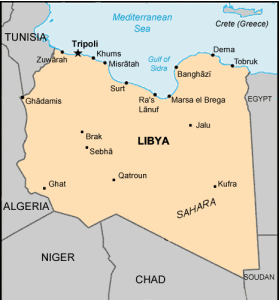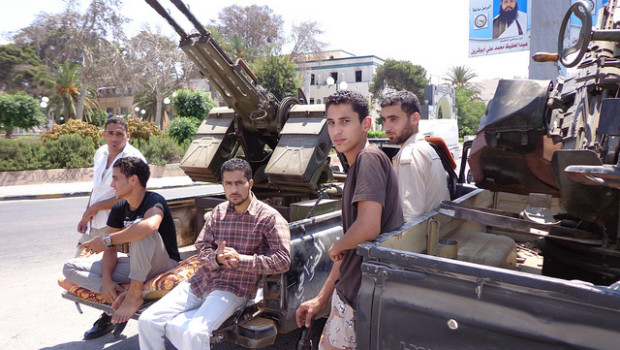NATO’s Libya: From successful model to failed state
Libya’s chaos and violence may seem like a continuum of painful replays. However, as the situation festers, the risk of extremist elements gaining a more dangerous foothold and broader freedom of action increases. Indeed, since the beginning of this year, militant Islamists have gained ground overall, undermining what little governance remains. Making matters worse, a Libyan Supreme Court decision has gone against the newly elected and relatively secular government.
Debating whether Libya is a failed state is academic even though the country has resembled one for the past six months. Even a senior Libyan official admitted back in August that most “factors at the moment are conducive to a failed state.” Unfortunately, Libya’s problems won’t be contained. Militant extremists and terrorists thriving amidst this mess will spread violence even farther beyond the country’s practically non-existent borders than they have already.
House of Cards
Most recognizable forms of authority in Libya have steadily imploded this year with the explosion of greater violence in the country’s two largest cities (Tripoli and Benghazi), the flight of foreign workers and embassies amidst kidnappings and murders, and the disarray affecting all manners of central governance (though its writ was already limited). In fact, Libya never evolved beyond the dominance of militias that refused to disarm following the struggle against Muammar al-Qadhafi.
Shaky stability in the capital city of Tripoli until mid-2014 depended on a wary balance of power between two powerful militias employed by Libya’s parliament, the General National Council (GNC). The Islamist militia comes from Libya’s third largest city of Misrata, while the other secular nationalist militia is from the tough Zintan mountain region south of Tripoli. The Misrata militia (now “Libya Dawn”) was linked to Islamist members, and the Zintani forces to its secular caucus. At the time, the GNC had a modest Islamist majority.
But the election in June of a secular majority permanent House of Representatives (HOR) triggered the collapse of the militia power balance. The larger Libya Dawn secured the upper hand over the Zintanis, seizing Tripoli. Libya Dawn reconvened mainly the Islamists from the GNC, proclaiming the body the true Libyan government.
The HOR fled east, taking refuge near the Egyptian border in the small city of Tobruk. Ex-General Khalifa Haftar’s effort since spring 2014 to crush extremists like the al-Qaeda affiliated Ansar al-Sharia in Libya (ASL) had experienced mixed results. Then, after solid gains against ASL forces in Benghazi in October, the beleaguered HOR embraced Haftar as acting on behalf of the newly elected parliament.
But the Libyan Supreme Court declared the internationally recognized HOR unconstitutional on November 6, arguing that the committee that prepared the election law for the June poll, which elected the HOR, violated Libya’s provisional constitution. The court remains, however, in Tripoli under Islamist occupation and originally was not asked to address the legality of the HOR, making its ruling questionable. Moreover, even if there were some inconsistencies involving election procedure, they pale against Libya Dawn’s violent seizure of Tripoli and revival of a rump GNC that no longer has any legal mandate whatsoever. The most recent election, quite an achievement under the circumstances, at least reflected voters’ preferences.

Consequently, despite urgings from some quarters that the HOR be abandoned, the UN and most foreign governments have not done so. As of Nov. 17, Turkey and Chad appeared to be the only exceptions. Embracing the court decision, the rump GNC has offered a national dialogue, something that would have been of value prior to Libya’s descent into far greater chaos in 2014. Earlier this year, when there was more to work with, I had discussed the advantages of such a meeting being held at a neutral venue abroad and being overseen by the UN along with the governments that backed the anti-Qadhafi struggle in 2011.
Of course, Libya has only spiraled further downwards since then. But because both governments share the need for revenue, Libyan exports still rebounded to more than 800,000 barrels per day (BPD) in September (although still only 1/3 of capacity). Following the court decision, however, Libya Dawn sought to control the country’s oil, seizing the 300,000 BPD western El-Sharara field. But Sharara was shut down, with Zintani forces blocking the pipeline to its northern export terminal of Zawiya. Then a security guard strike over unpaid wages closed Tobruk’s Hariga export terminal last weekend. These closures have driven exports down to barely 500,000 BPD.
Whether emanating from a now more aggressive Libya Dawn or the beleaguered ASL (most likely the latter), a number of bombings have also hit HOR-controlled locales in eastern Libya. One went off in the town of Shahat during a meeting there between HOR Prime Minister Abdullah al-Thinni and UN Libyan Envoy Bernadino Leon On Nov. 10. Several car bombings occurred two days later. One hit a busy street in front of the Tobruk hotel housing the HOR; another hit the airport used by al-Thinni near the town of Bayda. A third bomb blew up in Benghazi (where fighting between the forces of Haftar and the ASL has intensified again).
The fighting in Benghazi became so intense that Leon arranged a 12-hour humanitarian ceasefire on Nov. 19 so the Red Crescent could evacuate civilians and casualties from affected areas. The UN Security Council meanwhile blacklisted ASL branches in both Benghazi and Derna.
Located between Benghazi and Tobruk, Derna has been an extremist hotbed since the 1990s. Youthful demonstrators there declared their allegiance to the so-called Islamic State’s (ISIS or IS) “Caliph” Abu Bakr al-Baghdadi in late October. With Haftar’s air assets sorely limited, Egypt probably took aim at jihadi targets there with airstrikes on Nov. 12, despite Egyptian denials. Egyptian airstrikes have previously hit Tripoli and Benghazi. Fighter-bombers from the United Arab Emirates (UAE) have also staged through Egypt against Benghazi’s extremists.
Spillover Effect
Libya remains a vast arsenal of weapons, ammunition and explosives. The Sinai-based Beit al-Maqdis, which has sworn allegiance to IS, continues to receive Libyan munitions despite Egyptian countermeasures. The Jihadi group killed 33 Egyptian soldiers on Oct. 24. It struck again on Nov. 13, killing five soldiers and police. Near the northern end of the Suez Canal, militants or their smugglers had fired on an Egyptian Navy patrol boat wounding 5 sailors a day earlier, with eight others still missing. Sinai jihadists also released a lengthy video on Nov. 14 showcasing their suicide bombing that killed the soldiers in October, with participants shouting: “good news to al-Baghdadi!” The violence appears to be continuing unabated, with a likely Beit al-Maqdis bombing having hit a police checkpoint in a Cairo suburb just yesterday.
Libya also continues to export violence in various other directions. Four Tunisian soldiers were killed and 11 wounded in a Nov. 5 bus bombing. Much of the residual violence in Tunisia meanwhile stems from the cross-border infiltration of munitions from ASL. Malian jihadists, using Libya as an arsenal and for sanctuary, attacked a border village in Niger on Nov. 19, killing nine Nigerien security personnel.
With the West’s attention absorbed by IS, the negotiations over Iran’s nuclear program, Israeli/Palestinian affairs, and more, Libya has been woefully neglected. Yet the longer the country’s problems fester, the worse they will get. Indeed, even more IS-inspired connections with Libyan and associated jihadists surely will emerge in this chaotic environment. Simply watching Libya’s meltdown has achieved nothing.
Source:
http://www.lobelog.com/libya-failed-state/

